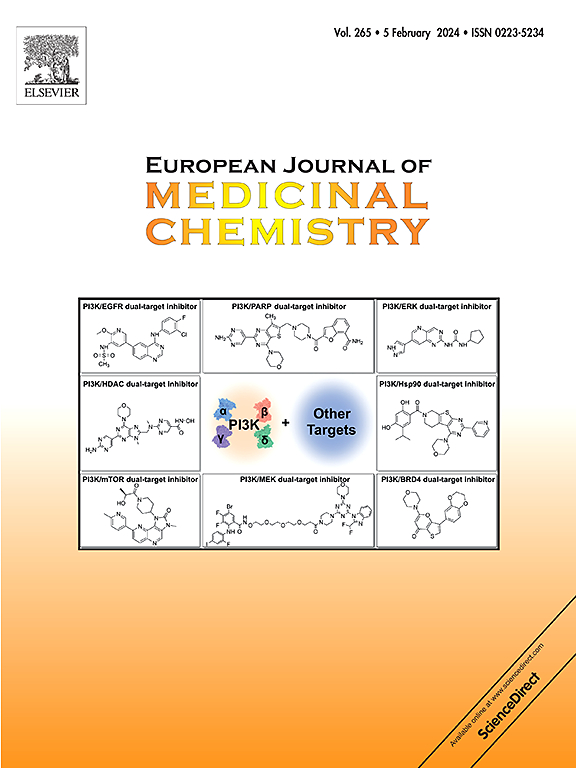Discovery of the first-in-class FABP/PPAR multiple modulator for the treatment of metabolic dysfunction-associated steatohepatitis
IF 6
2区 医学
Q1 CHEMISTRY, MEDICINAL
引用次数: 0
Abstract
Metabolic dysfunction-associated steatohepatitis (MASH) is a complex metabolic syndrome, and the development of new drugs is urgently needed. Fatty acid binding proteins (FABPs) and peroxisome proliferator-activated receptors (PPARs) play an important role in the regulation of lipid absorption, metabolism and inflammation. Considering the synergistic effect of FABP and PPAR in the regulation of MASH pathophysiology, the development of FABP/PPAR multiple modulators might be a promising anti-MASH strategy. Herein, the first-in-class FABP/PPAR multiple modulators were designed by hybrid resveratrol and PPARs agonist Elafibranor. Among them, the compound 27 was identified as the optimal FABP/PPAR multiple modulator (FABP1 IC50 = 0.65 μM, FABP4 IC50 = 1.08 μM, PPARα EC50 = 9.19 μM, PPARγ EC50 = 2.20 μM, PPARδ EC50 = 1.58 μM). Further MST assay confirmed the direct interaction of compound 27 and FABP1, providing a robust validation of its target specificity. In MASH mice, compound 27 exhibited a better therapeutic effect than clinical candidate obeticholic acid in ameliorating multiple pathological features of MASH. This study reported the successful discovery of the first-in-class FABP/PPAR multiple modulators, which provided preliminary evidence that such multi-target agents have broad medical prospects.


发现一流的FABP/PPAR多重调节剂治疗代谢功能障碍相关脂肪性肝炎
代谢功能障碍相关性脂肪性肝炎(MASH)是一种复杂的代谢综合征,迫切需要开发新药。脂肪酸结合蛋白(FABPs)和过氧化物酶体增殖激活受体(PPARs)在脂质吸收、代谢和炎症的调节中发挥重要作用。考虑到FABP和PPAR在调节MASH病理生理中的协同作用,开发FABP/PPAR多重调节剂可能是一种很有前途的抗MASH策略。本文以白藜芦醇和PPAR激动剂Elafibranor为原料,设计了同类首创的FABP/PPAR复合调节剂。其中,化合物27被确定为最佳的FABP/PPAR多路调制器(FABP1 IC50 = 0.65 μM, FABP4 IC50 = 1.08 μM, PPARα EC50 = 9.19 μM, PPARγ EC50 = 2.20 μM, PPARδ EC50 = 1.58 μM)。进一步的MST分析证实了化合物27与FABP1的直接相互作用,为其靶特异性提供了强有力的验证。在MASH小鼠中,化合物27在改善MASH的多种病理特征方面表现出比临床候选奥贝胆酸更好的治疗效果。本研究报道了同类首次成功发现的FABP/PPAR多重调节剂,为这类多靶点药物具有广阔的医学前景提供了初步证据。
本文章由计算机程序翻译,如有差异,请以英文原文为准。
求助全文
约1分钟内获得全文
求助全文
来源期刊
CiteScore
11.70
自引率
9.00%
发文量
863
审稿时长
29 days
期刊介绍:
The European Journal of Medicinal Chemistry is a global journal that publishes studies on all aspects of medicinal chemistry. It provides a medium for publication of original papers and also welcomes critical review papers.
A typical paper would report on the organic synthesis, characterization and pharmacological evaluation of compounds. Other topics of interest are drug design, QSAR, molecular modeling, drug-receptor interactions, molecular aspects of drug metabolism, prodrug synthesis and drug targeting. The journal expects manuscripts to present the rational for a study, provide insight into the design of compounds or understanding of mechanism, or clarify the targets.

 求助内容:
求助内容: 应助结果提醒方式:
应助结果提醒方式:


